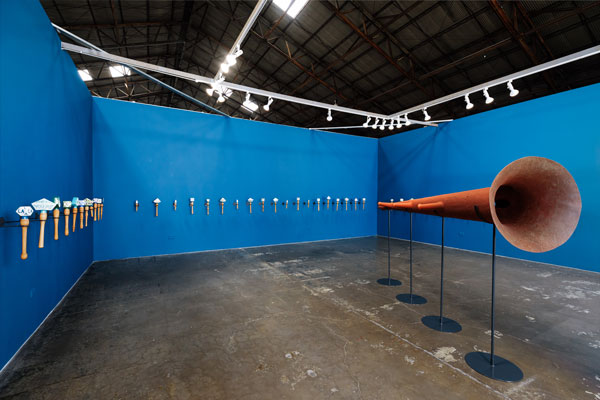While an artist-in-residence at Artpace, in San Antonio TX, Elana Mann created work for her exhibition “Year of Wonders.” Executed during the height of the recent pandemic and inspired by Geraldine Brooks’ Year of Wonders (2001) that focused on the 1666 pandemic plague in England, Mann’s installation considers both the civil unrest and the isolation that occurred during the year of COVID-19. Mann has reprised the exhibition as “Year of Wonders, redux” for 18th Street Arts Center.
At the center of the gallery sits the large sculpture Our work is never done (unfinished business) (2020–21), a fiberglass bullhorn, 120-feet long with multiple speaking tubes, modeled on the Mega-kazoo-horn originally made by the legendary folk music figure Charles Chase. It also recalls Erika Rothenberg’s Freedom of Expression National Monument, (1984)—originally presented in New York for Creative Time’s annual program Art on the Beach—another participatory sculpture that invited viewers to broadcast their thoughts. Mann conceived her piece as a protest horn, meant to be played by six people simultaneously to harness the power of a collective voice. The pandemic, however, has prevented the sculpture from fulfilling Mann’s intentions. It must be experienced individually. At 18th Street, it beckons seductively, yet remains silent.

Elana Mann, Condemnation, from the “blame-game rattle” series, 2018. Ceramic, wood, glass. 16” x 7” x 9”. Pitzer College Art Galleries, Claremont, CA. Photo by Michael Underwood. Courtesy of the artist.
The deep blue gallery walls feature 50 unique rattles; each has a turned wooden handle and is capped with a ceramic top glazed with words or phrases. Collectively titled Unidentified Bright Object 11-60 (2020), these rattles all have different sounds, shapes and words. Viewers may—with a white-gloved hand—shake the rattles to create myriad sounds that become individual voices within the space. Choosing from such texts: We/Me, No, Speak, Stand Up, People/Power, Hear, Peace, and Go, it is possible to compose slogans and rhythms in one’s mind.
The rattles function as both wall-based sculptures and sound instruments. Upon entry, one is encouraged to shake the rattles while circling the exhibition. Their varying weights and disparate sounds produce a gratifying experience, an enjoyable contrast to technological interaction.
There are also works on paper on view, including After Sister Mary Corita Kent and Rising waves (2021), a five-panel edition depicting abstracted waves with a text attributed to the economist, journalist and policy advisor Barbara Ward that reads: “… we are either going to become a community or we are going to die,” and the compelling Self-portrait as radical empath (dedicated to Pauline Oliveros) (2021) where a line drawing of the artist’s head fuses with the bell of a horn. Two short videos fill a darkened space— one more abstract—an imagined landscape of floating instruments, while the other documents possible commands, sounds and gestures of the rattles. Here, hands are filmed shaking rattles proclaiming “hope” and “no” that pulsate against a bright pink background. They are followed by “see” “hear” “know” which then becomes “see” “peace” “help.” “Truth” and “shame” also appear. These words are a call to action—expressing some of what has occurred during the last year.











0 Comments